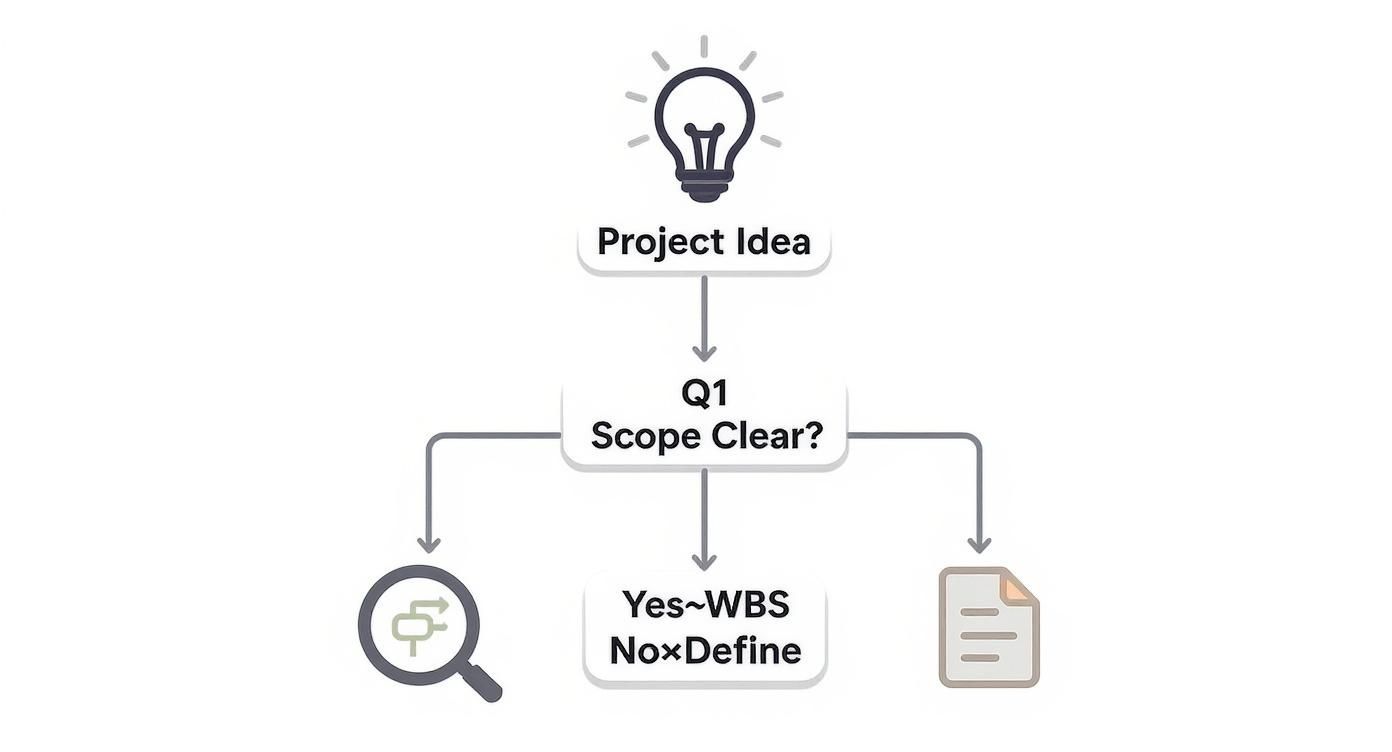A Guide to Software Project Estimating
Let's face it: estimating software projects is notoriously hard. If you've ever been part of a team that watched a deadline sail by while the budget evaporated, you know exactly what I mean. The problem isn't usually a lack of skill or effort. It's that we, as humans, are natural optimists who consistently downplay complexity.
The good news is that we can get better at this. The solution isn't to find a magic formula, but to build a process that acknowledges our biases and relies on data and structured thinking instead of gut feelings.
Why Software Project Estimates Usually Fail

We've all been there. A project kicks off with a confident timeline, only to end up in a frantic scramble. This happens to even the sharpest teams because we treat estimation like a simple prediction when it's really a complex forecasting exercise. We're fighting against a powerful combination of human psychology, hidden project complexities, and often, broken processes.
It’s time we stopped falling into the same old traps.
The Optimism Bias Trap
There's a well-documented cognitive bias called the planning fallacy. In simple terms, it means we’re wired to underestimate how long a task will take, even when we have direct experience telling us otherwise. We automatically focus on the best-case scenario and conveniently forget all the little things that went wrong last time.
Think about it. A developer might estimate a new feature at two days, recalling the smooth, uninterrupted coding they did on a similar task. What they’re forgetting is the three hours they spent wrestling with a cryptic API error or the half-day that vanished into a server configuration nightmare. That’s the planning fallacy in action.
Ignoring Hidden Complexities
A project scope is never as clean as it looks on paper. Once you start digging in, the "unknown unknowns" begin to surface, and these are what truly derail our estimates.
A few usual suspects are always lurking:
- Vague Requirements: When a feature description is ambiguous, it leaves the door wide open for misinterpretation and inevitable rework. Investing in solid agile requirements documentation upfront is one of the best ways to fight this.
- Technical Debt: Every shortcut and quick fix from the past is a landmine waiting to go off. That "simple" change can suddenly require a major refactor when it touches a brittle part of the codebase.
- Third-Party Dependencies: The moment you rely on an external API, library, or service, you're introducing uncertainty. An unexpected update on their end can cause a chain reaction of failures on yours.
"A new house blew out my effort assumptions this time. The shifting sands of software development practices are like moving into new houses multiple times each year."
This quote really nails it. You might have built a similar feature ten times before, but doing it in a new framework, with a different team, or for a new client is like trying to install the same appliance in a completely different house. You're bound to run into unexpected plumbing or wiring issues.
Don’t just take my word for it. The data is sobering. Empirical studies looking at over a decade of project data have shown that underestimation isn't just off by a little—it's often off by multiples of 2, 3, or even 4 times the actual effort required. Once you accept this reality, you can start building an estimation process that's resilient enough to handle it.
To help you sidestep these common issues, I've put together a table highlighting the most frequent missteps I've seen over the years and the pain they inevitably cause.
Common Estimation Pitfalls and Their Consequences
| Common Pitfall | Description | Resulting Consequence |
|---|---|---|
| Ignoring Non-Coding Tasks | Forgetting to budget time for meetings, code reviews, testing, deployment, and documentation. | The timeline only accounts for "hands-on-keyboard" time, leading to immediate schedule slips. |
| Pressure from Stakeholders | Accepting an unrealistic deadline to please a manager or client, hoping to "make it work." | Team burnout, poor quality code, and a high-stress environment. The deadline is missed anyway. |
| Assuming Seniority = Speed | Believing a senior developer is always 5x faster than a junior, ignoring domain knowledge gaps. | Misallocated work, bottlenecks, and junior developers not getting chances to learn. |
| Failing to Re-Estimate | Treating the initial estimate as set in stone, even when new information or scope changes emerge. | The project plan becomes increasingly detached from reality, making it impossible to manage effectively. |
Understanding these pitfalls is the first step toward creating estimates that you and your team can actually stand behind. They serve as a crucial checklist of what not to do as you build your own reliable process.
Laying the Groundwork for Accurate Forecasts
A solid estimate isn't pulled out of thin air. It’s the direct result of putting in the right prep work upfront. Before you even think about putting numbers to tasks, you need to build a solid foundation. This is what separates a data-driven forecast from a wild guess, and honestly, it’s not something you can afford to skip.
The first thing to do is break the project down into the smallest possible pieces. A classic way to do this is with a Work Breakdown Structure (WBS), which is just a fancy term for a hierarchical list of everything the team needs to do. This simple exercise forces you to think through every task, sub-task, and dependency, leaving no stone unturned.
This process is how you get from a vague idea like "build user profiles" to a concrete checklist: design the database schema, create the API endpoints, build the front-end UI, wire up the authentication logic, write the tests. It’s a lot easier to estimate each of those small items than it is to guess at the entire feature.
Defining Your Scope and Assumptions
Once you have that detailed breakdown, you need to draw a firm line in the sand. A well-defined scope statement becomes your guide, clearly stating what's in the project and—just as important—what's out. This is your best defense against scope creep, that silent project killer where tiny, unapproved additions slowly blow up your timeline and budget.
Right alongside the scope, you have to spell out your assumptions. These are the things you're taking for granted for your estimate to be accurate.
- Team Availability: Are you assuming your lead dev is dedicated 100% to this project, or are you realistically accounting for the time they spend on other maintenance tasks?
- Technical Environment: Is the staging environment stable and ready to go, or is setting it up actually part of the work?
- Third-Party Dependencies: Are you counting on that external API to be reliable and well-documented? What if it isn't?
Writing these down isn't about covering yourself; it's about being transparent and flagging risks for everyone to see. If you want to get more organized with this, our guide on https://makeautomation.co/what-is-process-documentation/ can help formalize the process.
An estimate is only as good as the assumptions it's built on. If your assumptions are wrong, your estimate will be too. Stating them clearly lets the whole team challenge and validate them before anyone writes a single line of code.
Leveraging Historical Data
Your best estimation tool is your own history. Trying to guess how long a task will take is one thing, but knowing how long a similar task actually took in the past grounds your forecast in reality. When you're trying to nail down accurate forecasts, you have to look at all potential costs—for example, decoding offshore software development costs can add crucial financial context to your budget.
Teams that consistently track and review data from old projects can spot patterns, learn from past mistakes, and see where their initial guesses went wrong. This feedback loop is what turns good estimators into great ones.
Even if your tracking hasn't been perfect, you can still dig up valuable intel. Sift through old project boards, look at commit histories, or even search through team chat logs. The goal is to find a few comparable tasks to see how the original guess stacked up against the final effort. This kind of reality check is absolutely essential for getting better at estimation.
Choosing the Right Estimation Technique
Let’s get one thing straight: there’s no silver bullet for estimating software projects. Anyone who tells you there is a single “best” method is selling something. The right technique for you will depend entirely on your project's size, its complexity, where you are in the project lifecycle, and frankly, how much you actually know about what you're building.
Trying to force a one-size-fits-all approach is a classic rookie mistake that leads to frustration and wildly inaccurate forecasts. The real key is matching the tool to the job. If you have a well-defined project with a rock-solid scope, a detailed estimation method is perfect. But for an early-stage idea or an Agile project where change is expected, you need something more flexible.
When Precision Is Paramount: Bottom-Up Estimating
If your project scope is locked down and you have a detailed Work Breakdown Structure (WBS), then bottom-up estimating is your most trustworthy friend. This is exactly what it sounds like: you estimate every single individual task—down to the smallest component—and then add them all up to get the project total.
It’s granular, it's thorough, and it leaves very little room for ambiguity.
Because you’re estimating tiny, manageable chunks of work, each forecast tends to be much more accurate. This method forces you to think through every step, every dependency, and every potential hiccup, which is great for uncovering hidden work you might have otherwise missed. The tradeoff? It’s incredibly time-consuming and demands a crystal-clear understanding of the project from the get-go.
This quick decision tree can help you figure out if your scope is clear enough for this kind of detailed approach.

As you can see, a clear scope is the entry ticket to breaking down the work effectively, making a bottom-up estimate not just possible, but powerful.
For Agile Teams: Relative Estimation
For most modern development teams, especially those running Agile, estimating in hours feels unnatural and often counterproductive. Enter relative estimation. This approach completely shifts the conversation from "how long will this take?" to "how big is this compared to other things we've done?"
It's a smart move because it plays to our strengths as humans—we're much better at comparing things than we are at predicting absolute futures.
Two popular ways to do this are:
-
Planning Poker: The team uses a deck of cards with a number sequence (often Fibonacci: 1, 2, 3, 5, 8…) to vote on the "size" of a user story. This size, called story points, is an abstract measure of effort, complexity, and uncertainty all rolled into one. The real magic happens in the discussion it sparks, which quickly surfaces different assumptions and gets everyone on the same page.
-
T-Shirt Sizing: This is a quicker, less formal method that's perfect for early-stage planning or high-level backlog grooming. The team simply assigns tasks a size like XS, S, M, L, or XL. It's a fantastic way to get a rough order of magnitude without getting bogged down in endless debate over numbers.
The beauty of these methods is that they decouple the estimate from time, which takes a ton of pressure off developers and keeps the focus on the work itself. Over time, you can track your team's velocity—the average number of story points they complete in a sprint—to generate some of the most reliable, data-driven forecasts you'll ever see. You can dig deeper into how these techniques fit into different workflows by checking out these project management methodology comparisons.
Other Specialized Estimation Models
While bottom-up and relative sizing will get you through most situations, a few other techniques are incredibly useful in the right context. Knowing about them gives you a more complete toolkit.
Comparison of Software Estimation Techniques
Choosing the right estimation method is all about context. This table breaks down some of the most common techniques to help you see where each one shines and what pitfalls to watch out for.
| Technique | Best For | Pros | Cons |
|---|---|---|---|
| Bottom-Up Estimating | Well-defined projects with a clear scope and a detailed Work Breakdown Structure (WBS). | Highly accurate and detailed. Uncovers hidden tasks and dependencies. | Very time-consuming. Requires a complete and stable scope upfront. |
| Relative Estimation | Agile projects where requirements evolve. Teams focused on long-term predictability over short-term precision. | Fast, collaborative, and reduces pressure. Focuses on complexity, not just time. Fosters team alignment. | Requires an established team and historical data (velocity) to be truly predictive. Can be confusing for stakeholders used to hours. |
| Parametric Estimating | Repetitive or scalable tasks where reliable historical data is available. | Objective and data-driven. Can be very fast if you have the right historical metrics. | Only as good as the data you have. Not suitable for unique or highly creative work. |
| Three-Point Estimating | High-risk projects or tasks with a high degree of uncertainty. | Accounts for risk and uncertainty. Provides a probable range, not a single false number. Encourages realistic thinking about potential problems. | Can be complex to calculate and explain. Relies on subjective "best-case" and "worst-case" guesses. |
Ultimately, the best approach is often a hybrid. You might use T-shirt sizing for a high-level roadmap and then switch to Planning Poker for sprint-level work.
Parametric Estimating
This model leans on historical data and a bit of statistical modeling to predict future effort. For instance, if you know from past projects that each new API endpoint takes, on average, 12 hours to build, you can use that statistic to estimate a new project with 10 endpoints at around 120 hours. The catch? This technique is only as good as the data you feed it. It’s perfect for repetitive tasks where you have a strong, reliable baseline.
Three-Point Estimating
This method wisely acknowledges that the future is uncertain. Instead of asking for a single number, you ask for three estimates for each task:
- Optimistic (O): The absolute best-case scenario, where everything goes right.
- Most Likely (M): Your realistic guess, accounting for typical small bumps in the road.
- Pessimistic (P): The worst-case scenario, where everything that can go wrong, does.
You then use a formula to calculate a weighted average. The most common one, from PERT analysis, is (O + 4M + P) / 6. This calculation gives more weight to the "most likely" outcome while still factoring in the risk baked into the pessimistic view.
Choosing your estimation technique is the first major decision you'll make, and it sets the tone for everything that follows. Picking a method that doesn't fit your project's reality—like forcing a bottom-up estimate on a vague scope—is where so many forecasts start to go off the rails. Always start by assessing what you know before deciding how you'll estimate.
Factoring in Risk and Uncertainty
An estimate without a plan for the unexpected is just a hopeful guess. We’ve all seen it: a team tacks on an arbitrary 20% at the end for "contingency." That’s not a plan; it’s a prayer. A truly professional forecast is built by proactively identifying, assessing, and planning for the things that can and will go wrong.
This isn’t about pessimism; it’s about professionalism. Real-world projects are messy. People get sick, third-party APIs go down, and requirements that seemed crystal clear suddenly become ambiguous. Ignoring these realities is a direct path to blown budgets and missed deadlines. To move from a fragile number to a resilient forecast, you need a structured way to manage risk.
Creating a Risk Register
First things first, get all those potential problems out of your head and onto paper. This is where a risk register comes in—basically, a running log of everything that could derail your project. You don't need fancy software for this; a simple spreadsheet works perfectly.
Get your team together and brainstorm potential issues. Walk through every phase of the project, from initial design to final deployment. A good pro-active risk assessment is key here, as it helps you spot threats before they ever become a problem.
Once you have a list, it's time to quantify. For each risk, assign two scores, usually on a scale of 1 to 5:
- Probability: How likely is this to happen? (1 = Very Unlikely, 5 = Almost Certain)
- Impact: If it does happen, how bad is the damage? (1 = Minor Hiccup, 5 = Project Killer)
Now, multiply those two numbers to get a risk priority score. This simple calculation immediately tells you where to focus. A low-probability, low-impact risk can just be noted, but anything with a high score demands a concrete mitigation plan.
Planning for Known and Unknown Unknowns
Risks generally fall into two buckets, and you need a different strategy for each. It’s a concept that sounds a bit academic, but in practice, it’s incredibly straightforward.
First up are the known unknowns. These are the risks you can see coming, even if you don't know the exact details. Think of them as predictable uncertainties.
For example, you know someone on the team will take a vacation or call in sick during a multi-month project. You just don't know who or when. This is a classic known unknown. You can plan for it by building a specific buffer into the schedule for team unavailability.
Other common examples include potential delays in getting stakeholder feedback or the time needed to set up a new server environment. For each of these, you can create a specific plan and assign a time or budget buffer directly to that line item in your risk register.
The second, trickier category is the unknown unknowns. These are the problems you couldn't possibly predict. The surprise security vulnerability found in a core library you depend on. The cloud provider outage that takes your systems offline for a day. The key framework that gets deprecated mid-project.
You can't create a specific plan for these because, by definition, you have no idea what they are. So, how do you handle them?
This is where your general project contingency buffer comes from. This isn't for the risks you've already identified in your register. It’s a separate fund to absorb the truly unforeseeable shocks. The size of this buffer should reflect the project's overall uncertainty—a straightforward, well-understood project might only need a 10% buffer, while a highly innovative one using brand-new tech might warrant 30% or more.
By separating your risk planning this way, your estimates become far more robust and grounded in reality.
Communicating Estimates to Stakeholders

Running the numbers is only half the job. Honestly, it might be the easier half. The real test comes when you have to present that estimate to stakeholders. How you communicate your forecast can make or break the project before a single line of code is written.
Get it wrong, and you're starting with a foundation of mistrust and unrealistic pressure. But get it right, and you're not just a project manager—you become a trusted advisor who helps guide the business toward a successful outcome. It’s all about building a shared understanding of the scope, the risks, and what's realistically achievable.
Frame the Conversation with Ranges
If you take only one thing away from this guide, let it be this: never, ever present your estimate as a single number. A single date or dollar amount isn't a forecast; it's a promise. A fragile one. It creates a false sense of certainty and sets everyone up for disappointment the moment the first unexpected problem pops up.
Always present your estimate as a range. A simple three-point estimate is incredibly effective for this:
- Best-Case Scenario: This is your optimistic, everything-goes-right timeline. The team is in perfect flow, dependencies arrive on time, and no major bugs appear. Be crystal clear that this is the least likely outcome.
- Most Likely Scenario: This is your core estimate—the one you're actively planning around. It accounts for normal interruptions, minor delays, and the typical back-and-forth of development.
- Worst-Case Scenario: This number incorporates your biggest known risks. What happens if a key developer gets sick for a week? What if that third-party API isn't ready on time? This is that number.
This simple shift from a single date to a range completely changes the conversation. It moves from "Can you hit this exact date?" to "What can we do together to stay closer to the best-case end of this range?"
Make Assumptions and Risks Explicit
Every estimate is built on a pile of assumptions. If any of them prove wrong, your whole forecast can crumble. Don’t ever assume that stakeholders know what these are. You have to spell them out, clearly and directly.
When you present your numbers, attach a concise list of the foundational assumptions you’ve made. Think of it as the "terms and conditions" of your estimate.
For example:
- Team Availability: "This plan assumes our two senior engineers are 100% allocated to this project."
- Stakeholder Feedback: "We've budgeted for a 48-hour turnaround on all design approvals and content."
- Technical Dependencies: "This timeline is contingent on the new payment API being publicly available by July 15th."
This isn't about making excuses upfront. It’s about building a shared reality and identifying the plan's weak points together. When stakeholders see these conditions, they become co-owners of the estimate's success because they understand their role in helping it come true.
Your job isn't to be a fortune teller; it's to be a risk manager. Communicating the "why" behind your numbers—the assumptions, dependencies, and potential pitfalls—is what builds the trust necessary to navigate a project successfully.
Defend Your Estimate with Confidence
Sooner or later, it will happen. A stakeholder will look at your estimate and ask, "Can we do it faster? Cheaper?" The pressure can be immense, but how you respond is critical. Don't just cave and agree to trim the numbers.
Treat this as the beginning of a negotiation, not a command. Your estimate is a direct reflection of the work they asked for. If they want to change the timeline or budget, the scope has to change with it.
Frame your response around options and trade-offs. Try something like this: "To hit that new deadline, we'd need to make some choices. We could launch without the advanced reporting module and build it in phase two, or we could simplify the user profile customization. Which of those is more important for the initial release?"
This approach does two crucial things: it reinforces that your estimate is based on real work, not just arbitrary numbers, and it empowers the stakeholder to make an informed business decision. You aren't saying "no." You're saying, "Yes, and here's what that choice means." This is how you collaborate your way to a successful delivery.
Answering Your Toughest Software Estimation Questions
Even when you follow the best practices, estimating software in the real world gets messy. You'll always run into tricky situations, especially when you're wrestling with tight deadlines, requirements that won't stay put, and pressure from stakeholders. Let's tackle some of the most common challenges I've seen teams face over the years.
Think of this as moving from theory to the trenches. It’s one thing to understand the concepts; it’s another thing entirely to apply them when a project's success is on the line.
How Do You Estimate a Project with Many Unknowns?
When a project is riddled with uncertainty, giving a single, precise number for the whole thing is just asking for trouble. Don't guess. Instead, embrace the ambiguity by breaking your approach into phases.
Start by providing a detailed, high-confidence estimate for a small, initial discovery phase. The only goal of this phase is to untangle the unknowns and get real clarity on the requirements. For everything that comes after, offer a rough order of magnitude (ROM) estimate, and make sure it’s a wide range (e.g., 4-8 months).
Be crystal clear with stakeholders that this range isn't a commitment—it's a forecast based on what you know right now. A more precise estimate for the development work will only come after the discovery is done. This approach actively manages expectations and shows you have a clear plan for chipping away at the uncertainty.
What Is the Best Way to Handle Pressure to Reduce an Estimate?
Ah, the classic scenario. You present a thoughtful estimate, and the first thing you hear back is, "Can we do it for less?" Whatever you do, don't just arbitrarily cut the number to make them happy. Doing so devalues your entire process and sets a terrible precedent for the future.
Instead, reframe their request as a scope negotiation. Your estimate is a direct result of the work required. If the budget or timeline has to shrink, the scope has to shrink with it. Turn the conversation into one about trade-offs.
Put concrete options on the table:
- "To hit that lower budget, we could push the real-time analytics dashboard and the admin user roles into a later phase."
- "We can meet that tighter deadline, but we’d have to simplify the integration, which would mean more manual data entry for the operations team."
This shifts the focus from a random number to a collaborative decision about what truly matters. It shows your estimate is based in reality and that cutting it has real, tangible consequences.
How Often Should We Re-Estimate a Project?
Your estimate isn't a historical document carved in stone. It should be a living, breathing thing that evolves as the project does. For teams working in an Agile way, estimation is already a continuous activity—it happens every single sprint planning meeting as new work gets sized up.
For longer, more traditional projects, you should plan to formally re-estimate at key milestones. A great time to do this is after a major phase wraps up, like when the design and prototyping stage is finally complete.
But here’s the most important rule: you must re-estimate anytime something significant changes. This could be a shift in scope, finding out a core assumption was wrong, or a major new risk popping up. By making re-estimation a standard part of your process, you ensure the project plan always reflects reality, not wishful thinking.
My Team Hates Estimating in Hours. What Are the Alternatives?
I hear this all the time, and for good reason. Estimating in hours can feel completely arbitrary, it creates a ton of pressure, and it often leads to people being judged on speed instead of the quality of their work. The best alternative by a mile is relative estimation using story points.
Instead of asking, "How many hours will this take?" the team asks a much better question: "How big is this task compared to other tasks we've already done?"
Teams use an abstract scale (the Fibonacci sequence—1, 2, 3, 5, 8, 13—is a popular choice) to assign points based on a blend of effort, complexity, and uncertainty. This brilliantly decouples the estimate from the clock and gets everyone focused on what really matters: understanding the work itself.
After a few sprints, you can calculate your team's average velocity—the number of story points they consistently complete. This simple metric becomes an incredibly powerful, data-driven tool for forecasting future work, all without ever asking someone for an hourly guess.
Navigating the complexities of software project estimation is a critical skill for scaling your operations effectively. At MakeAutomation, we specialize in creating the robust project management frameworks and automated workflows that B2B and SaaS companies need to grow. If you're ready to replace guesswork with a predictable system, explore how we can help.






